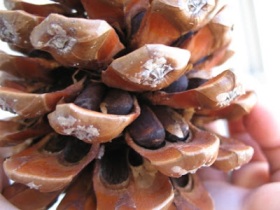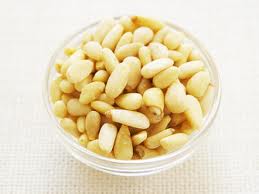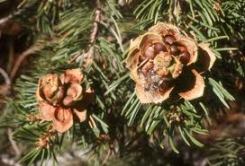 Pine nuts, also called pignoli, piñons, and Indian nuts, depending on the variety, are the seeds of various species of pine trees. Of the more than one hundred pine tree species around the world, about a dozen in the Northern Hemisphere yield desirable seeds, the three most prevalent being the Pinus pinea (Mediterranean stone pine), Pinus cembroides (Mexican nut pine), and Pinus edulis (piñon pine of the south-western United States).
Pine nuts, also called pignoli, piñons, and Indian nuts, depending on the variety, are the seeds of various species of pine trees. Of the more than one hundred pine tree species around the world, about a dozen in the Northern Hemisphere yield desirable seeds, the three most prevalent being the Pinus pinea (Mediterranean stone pine), Pinus cembroides (Mexican nut pine), and Pinus edulis (piñon pine of the south-western United States).
Pine species that produce edible nuts grow in northern Mexico, the south-western United States, Europe, Asia, North Africa, and South America. Their seeds range in size from the 1/2-inch seeds found in Mexican, American, and European pines to the giant 2-inch seeds of the nut pines in South America.
A single pine cone may contain a hundred seeds, but they are lodged securely within the cone, which must be heated to open the scales and loosen the nuts, enabling their removal. After the nuts have been shaken free, the hull protecting each individual nut must be cracked open. This intensive two-step process is the primary reason for their high price tag.
 If you’ve already tried pine nuts, you’ve most likely eaten the seeds of the Mediterranean stone pine, Pinus Pinea, a tree found from Portugal to Italy to Lebanon that provides the most widely available nut. Shaped like a torpedo, these soft, ivory-colored, 1/2-inch pignoli have a light, delicate flavor with a piney, resinous undertone.
If you’ve already tried pine nuts, you’ve most likely eaten the seeds of the Mediterranean stone pine, Pinus Pinea, a tree found from Portugal to Italy to Lebanon that provides the most widely available nut. Shaped like a torpedo, these soft, ivory-colored, 1/2-inch pignoli have a light, delicate flavor with a piney, resinous undertone.
Piñons are similar to pignoli in taste and appearance, but the Chinese pine nut, which is shaped like a squat triangle, has a pungent pine flavor so intense it can overpower some dishes.
Pignoli are a ubiquitous ingredient in the cuisines of the Mediterranean, Middle East, and North Africa, where they are eaten by the handful as snacks and used in a wide variety of recipes, including classic Italian pesto. Piñons have also enhanced the traditional dishes of Mexico and Native Americans living in the south-western United States for many centuries.
History
Not surprisingly, all cultures where nut-bearing species of pines grow have valued their edible seeds since time immemorial. It is thought that the pine nuts from the North American piñon tree were eaten as a staple food some 10,000 years ago, and species are also to be found in Korea, China, Turkey, Pakistan, and Afghanistan, where they have been a traditional food of nomadic tribes.
Piñons were so important a food for Native Americans throughout the region that they were called Indian nuts and are still harvested in quantity by Native Americans, both for food and for trading.
In the 1500s, Spanish chroniclers traveling among the Hopi and Navajo nations recorded pine nuts being eaten whole, ground for flour and baked, pounded into a buttery paste, used in soup, and either boiled or roasted to make a nourishing porridge. The seeds were cached against long winters, serving as the mainstay of the Native American’s diet when weather conditions prevented hunting for fresh meat.
Despite this description of use in America, pine nuts are most often associated with the Mediterranean region, in particular Italy, where they have been used as a n ingredient for well over 2,000 years. Evidence found in the ruins of Pompeii, an Italian town destroyed when the volcano Mount Vesuvius erupted in 79 C.E., show that pine nuts were widely used at that time.
Some research indicates that the species now grown in Europe, Pinus pinea, originated in the Near East and that it was humans who gradually spread it throughout the Mediterranean.
Valued by ancient Greeks and Romans as an aphrodisiac, pine nuts are still a favorite ingredient in Italian cuisine.
Pignoli are also used in a variety of French meat dishes, in crudités (raw vegetable salads), and in pastries and baked goods such as macaroons.
 In Greece and Turkey pine nuts, often along with currants, are an integral ingredient in a number of pilaf rice dishes.
In Greece and Turkey pine nuts, often along with currants, are an integral ingredient in a number of pilaf rice dishes.
In North Africa, pine nuts are common ingredients in confections; in Tunisia, they are often added to mint tea, the regions ubiquitous equivalent of the American cup of coffee.
In India, where they are called chilgoza, pine nuts garnish rice dishes and add their sweet richness to desserts, puddings, sauces, and sweetmeats.
Finally in Korea they are used in a sustaining breakfast porridge, ginger tea, and confections.
Although 3,000 or more metric tons of pine nuts are produced annually in Mexico and the south-eastern United States, little of this crop enters the nut trade. The majority of pine nuts commercially available in the United states are imported from Italy and Spain, the world’s top producers.
Nutritional Highlights
European pine nuts, or pignoli, which deliver 24 grams of protein per 3.5 ounces (100 grams), contain more protein than any other nut or seed. An ounce of pignoli contains more protein (6.8 grams) and less fat (14 grams), fiber (1.3 grams), and carbohydrate (4 grams) than their American cousins, piñons, which provide 3.3 grams of protein, 17 grams of fat, 3 grams of fiber, and 5.5 grams of carbohydrate. The fat provided by both types of nuts is about 50 percent monounsaturated, 40 percent polyunsaturated, and 10 percent saturated.
 Pignoli supply160 calories per ounce, while the same amount of piñons provides 178 calories. Per ounce, piñons contain more vitamin B1 (32 percent the recommended daily intake compared to 21 percent of the recommended daily intake of pignoli, although both nuts qualify as an excellent source), while pignoli contain more iron (14 percent of the recommended daily intake compared to the 5 percent in piñons, which makes pignoli an excellent and piñons a good source of the mineral.)
Pignoli supply160 calories per ounce, while the same amount of piñons provides 178 calories. Per ounce, piñons contain more vitamin B1 (32 percent the recommended daily intake compared to 21 percent of the recommended daily intake of pignoli, although both nuts qualify as an excellent source), while pignoli contain more iron (14 percent of the recommended daily intake compared to the 5 percent in piñons, which makes pignoli an excellent and piñons a good source of the mineral.)
Both types of nuts provide comparable amounts of other vitamins and minerals. Both are an excellent source of vitamins B1 and B3, manganese, copper, magnesium, molybdenum, and zinc as well as being good sources of vitamin B2, E and potassium.
Health Benefits
The health benefits of pine nuts are similar to those of other nuts that provide a high content of monounsaturated fat and arginine. In addition both types of pine nuts deliver a hefty dose of magnesium and potassium, two minerals whose combined effects produce a strong, healthy heartbeat, lowered blood pressure, and improved blood flow.
Taken altogether, pine nut’s arginine, monounsaturated fat, magnesium, and potassium content provide powerful effects for counteracting heart disease.
Energetic and Magical Properties
 Gender: Masculine
Gender: Masculine
Planet: Mars
Element: Air
Influences: Fertility, Abundance
Pine cones containing seeds are carried throughout Europe to increase fertility and to retain your youth in old age. The seeds also make wonderful offerings to fairies, rumored to live and play inside pine trees; slain-god figures, whose immortality is reflected by the evergreen nature of pine trees; and to nature spirits in general.
To inspire abundance or fertility include them in altar arrangements and ceremonies. They can also be ingested to help bring these properties into your life, simply ask them to do so as you include them in dishes or as you snack on them whole.
How to Select and Store
Pignoli are widely available and are sold already shelled. Piñons are most likely to be available in the southwestern United States, where they are sold, already shelled, in the produce section of grocery stores and natural food markets. They can also be found still inside their shells by wild-harvesters on the side of busy roads, or at markets in the same area.
Asian markets are the best place to find Chinese pine nuts.
 Because of their high fat content, all varieties of pine nuts are extremely susceptible to rancidity. Purchase pine nuts that are packaged in an airtight container. Be sure to check the sell-by date on the package to ensure freshness.
Because of their high fat content, all varieties of pine nuts are extremely susceptible to rancidity. Purchase pine nuts that are packaged in an airtight container. Be sure to check the sell-by date on the package to ensure freshness.
Store all pine nuts in an airtight container in the refrigerator, where they will keep for up to three months, or an airtight ziplock bag in the freezer, where they will keep for up to nine months.
Tips for Preparing
Toasting shelled pine nuts will intensify their flavor and takes just 2-3 minutes in a dry skillet over medium heat or 6-8 minutes spread out on a cookie sheet in an oven preheated to 350 degrees F.
 Alternatively, rinse the pine nuts in cold water, drain, sprinkle with salt, put in a covered roasting pan, and steam at 250-275 degrees F. for 15-20 minutes. Remove the cover and stir until completely dry.
Alternatively, rinse the pine nuts in cold water, drain, sprinkle with salt, put in a covered roasting pan, and steam at 250-275 degrees F. for 15-20 minutes. Remove the cover and stir until completely dry.
To roast piñons inside their shells wash them thoroughly, spread out in a single layer on a cookie sheet while still wet, salt if desired then place into a preheated oven at 325 degrees F. Check them after 10 minutes by pulling one from the pan, cracking it and tasting it. If it still tastes raw they are not finished; also pay attention to the color of the meat inside the shell. When they become a light butterscotch color remove them immediately and cool thoroughly and evenly. Piñons can burn easily, so check them often as they roast.
*Safety*
There are significant safety issues with nut and seed consumption. As a general rule, nuts are among the foods more commonly associated with allergic reactions. Nut allergies also tend to be severe with a range of symptoms. Use caution when introducing nuts to children, or when trying new types of nuts yourself.
 A less serious safety issue with most nuts and seeds is they provide a high ratio arginine to lysine. While arginine does provide significant health benefits, a high arginine-to-lysine ratio is best avoided by people susceptible to cold sores or herpes infections, as arginine promotes, while lysine prevents, the activation of the virus.
A less serious safety issue with most nuts and seeds is they provide a high ratio arginine to lysine. While arginine does provide significant health benefits, a high arginine-to-lysine ratio is best avoided by people susceptible to cold sores or herpes infections, as arginine promotes, while lysine prevents, the activation of the virus.
Asthma-like symptoms have also been observed after consumption of pine nuts. Individuals living near a pine forest, who are therefore exposed and possible sensitized to pine tree pollen, may be more at risk to allergies involving pine nuts. Also, common antigenic (allergy-provoking) proteins have been identified in pine nuts and peanuts, so individuals with a peanut allergy may want to avoid pine nuts.
Nutritional Information per 100 Gram Serving
Calories: 566
Carbohydrates: 14.22 g
Fat: 50.7 g
Protein: 24 g
Fiber: 4.5 g
Water: 6.69 g
Stearic Acid: 1.672 g
Oleic Acid: 17.9 g
Linoleic Acid: 20.689 g
Linolenic Acid: 0.654 g
Arachidonic Acid: 0 g
EPA: 0 g
DHA: 0 g
Cholesterol: 0 mg
Monounsaturated Fat: 19.076 g
Polyunsaturated Fat: 21.343 g
Saturated Fat: 7.797 g
Calcium: 26 mg
Copper: 1.026 mg
Iron: 9.2 mg
Magnesium: 233 mg
Manganese: 4.298 mg
Phosphorous: 508 mg
Potassium: 599 mg
Selenium: 16.6 mg
Sodium: 4 mg
Zinc: 4.25 mg
Folic Acid: 0 mcg
Niacin: 3.57 mg
Pantothenic Acid: 0.208 mg
Riboflavin: 0.19 mg
Thiamine: 0.81 mg
Vitamin A: 29 IU
Vitamin B12: 0 mcg
Vitamin B6: 0.11 mg
Vitamin C: 1.9 mg
Vitamin E: 3.5 mg
Vitamin K: 0 mg
Recipes which Include Pine Nuts:
Ginger Tea (생강차 [Saenggangcha])
This article was adapted from:
The Encyclopedia of Healing Foods by Michael Murray N.D. and Joseph Pizzorno N.D. with Lara Pizzorno M.A. , L.M.T.
With Additional Information from:
The Master Book of Herbalism by Paul Beyerl
Cunningham’s Encyclopedia of Magical Herbs by Scott Cunningham
The Herb Book by John Lust
Pictures pulled from Google.com
